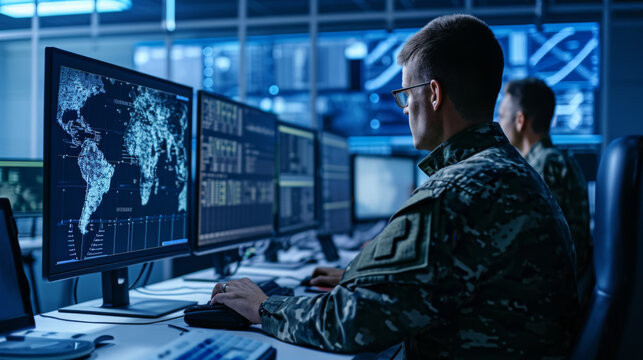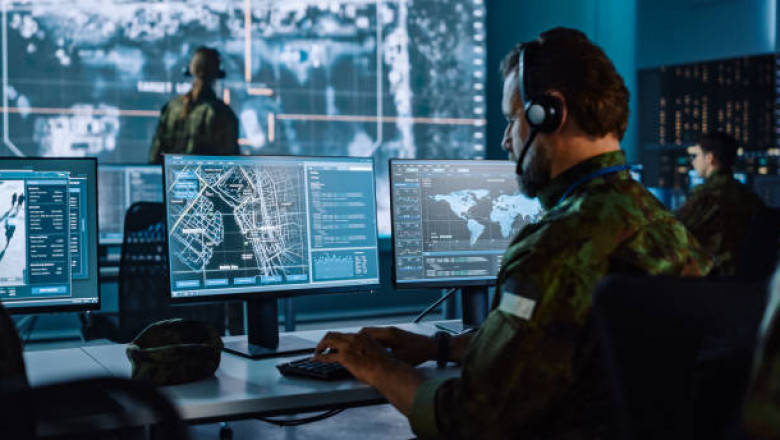views
How Are AI and Machine Learning Transforming Military Operations and Combat Training?

Introduction:
The integration of Artificial Intelligence (AI) and Machine Learning (ML) into military operations is no longer a distant concept but a present reality. These technologies have begun reshaping the way defense forces around the world prepare for and engage in conflict. One of the key areas where AI and ML are making significant strides is in military computer systems. With applications ranging from intelligence gathering to combat training simulations, these technologies are set to define the future of modern warfare.
Download FREE Sample of Artificial Intelligence Market
The Rise of AI and ML in Military Computer Systems
Military computer systems have long been a cornerstone of modern defense strategies, providing the infrastructure for everything from strategic planning to operational execution. Over the years, advances in AI and ML have brought about a paradigm shift in these systems, making them smarter, faster, and more efficient. The growing capabilities of AI and ML enable defense forces to process vast amounts of data in real-time, analyze complex situations, and make quicker, more informed decisions.
AI-powered systems can now predict and react to battlefield conditions with unprecedented accuracy. Machine learning algorithms, by continuously learning from past data, can identify patterns and make predictions that were once impossible to achieve. These capabilities have made AI and ML integral components of modern military computer systems, as they provide a competitive edge that is crucial for success in future conflicts.
AI-Powered Battlefield Surveillance: How Machine Learning is Enhancing Intelligence Gathering
One of the most significant uses of AI and ML in military operations is in surveillance and intelligence gathering. Traditional surveillance systems, such as satellite imagery or radar, provide valuable data, but they often require human analysis to interpret. The sheer volume of data collected can be overwhelming, and the process of manually analyzing this information can be time-consuming and prone to error.
AI and ML algorithms address this issue by automating the analysis of surveillance data. For example, machine learning models can rapidly process satellite images, detect changes in terrain, and identify potential threats. These models can also track the movements of enemy forces and predict their next moves based on historical data and observed patterns.
AI-powered systems can also integrate data from a variety of sources, including drones, sensors, and ground-based surveillance units, to create a comprehensive picture of the battlefield. This allows military commanders to make real-time decisions based on the most up-to-date information available. In addition, AI can help filter out irrelevant data, ensuring that analysts focus on the most critical information.
The use of AI and ML in surveillance is not limited to the gathering of intelligence; it also enhances the security of military assets. By continuously monitoring the battlefield and analyzing patterns, AI systems can detect potential threats, such as incoming missiles or enemy aircraft, and trigger automatic defensive measures. This proactive approach to security is vital in ensuring the safety of both personnel and equipment.
How Machine Learning is Revolutionizing Combat Training Simulations for Modern Soldiers
Another area where AI and ML are having a profound impact is in combat training simulations. Traditionally, military training has relied on live exercises, war games, and mock battle scenarios to prepare soldiers for real-world combat. While these methods have been effective, they are often expensive, time-consuming, and logistically challenging to execute on a large scale.
Machine learning is revolutionizing combat training by enabling the development of highly realistic and dynamic simulations. These simulations allow soldiers to experience a wide range of combat scenarios, including those that would be difficult or dangerous to recreate in real life. By using AI-powered simulations, soldiers can practice decision-making, strategic planning, and tactical maneuvers in a safe and controlled environment.
One of the key advantages of machine learning in combat training is its ability to adapt to the actions and behavior of the soldiers. In traditional simulations, scenarios are pre-programmed, and soldiers must follow a fixed script. In contrast, machine learning-enabled simulations can adjust in real-time based on the decisions made by the participants. This creates a more immersive and realistic experience, as soldiers must respond to unexpected changes in the scenario, much like they would in a real combat situation.
Moreover, AI-powered training systems can track a soldier’s performance and provide personalized feedback. By analyzing the actions of individual trainees, machine learning algorithms can identify areas for improvement and suggest targeted exercises to address specific weaknesses. This individualized approach ensures that each soldier receives the training they need to enhance their skills and improve their performance on the battlefield.
Enhancing Decision-Making Through AI and Machine Learning
In addition to surveillance and training, AI and ML are also playing a crucial role in enhancing decision-making during combat operations. The complexity of modern warfare means that military commanders are often faced with a large volume of data and rapid, high-stakes decisions. AI and machine learning systems are able to analyze this data and provide actionable insights, allowing commanders to make more informed decisions.
For example, AI algorithms can process information about enemy movements, terrain, weather conditions, and the status of military assets, and then provide recommendations on the best course of action. These recommendations can include tactical maneuvers, the allocation of resources, or strategic objectives. By providing commanders with timely, data-driven insights, AI and ML systems enable them to respond more quickly and effectively to evolving battlefield conditions.
Machine learning also plays a vital role in predictive analytics. By analyzing historical data, ML models can forecast potential outcomes of different actions, helping military leaders choose the most effective strategy. This predictive capability can be especially valuable in situations where time is of the essence, such as in combat operations or emergency response scenarios.
AI and Machine Learning in Autonomous Combat Systems
Another area where AI and ML are transforming military operations is in the development of autonomous combat systems. Unmanned aerial vehicles (UAVs), ground robots, and other autonomous systems are being integrated into military operations to perform tasks such as reconnaissance, logistics, and combat. These systems rely heavily on AI and ML to navigate the battlefield, identify targets, and make decisions without direct human intervention.
Autonomous combat systems are capable of operating in complex environments, where human operators may be at risk. For instance, drones equipped with AI can conduct surveillance missions in hostile territories, gather intelligence, and even engage enemy targets without putting personnel in harm's way. The use of machine learning algorithms enables these systems to learn from experience, improving their performance over time.
While autonomous combat systems are still in the early stages of development, their potential to revolutionize modern warfare is immense. With AI and ML driving advancements in autonomy, these systems are becoming increasingly capable of performing a wide range of tasks, from reconnaissance to offensive operations, with minimal human involvement.
The Future of AI and Machine Learning in Military Operations
As AI and machine learning continue to evolve, their impact on military operations will only increase. The ability to process large volumes of data in real-time, enhance decision-making, improve combat training, and develop autonomous systems will shape the future of warfare. In the coming years, we can expect to see even more advanced AI-powered systems deployed across various branches of the military.
However, the integration of AI and ML in military operations also raises important ethical and security concerns. Issues such as accountability, transparency, and the potential for unintended consequences must be addressed as these technologies become more prevalent on the battlefield. Ensuring that AI and machine learning systems are used responsibly and ethically will be crucial in maintaining a balance between technological advancement and human oversight.
Conclusion
AI and machine learning are transforming military computer systems, enhancing surveillance, training, decision-making, and combat capabilities. With ongoing advancements in these technologies, the future battlefield will be shaped by smarter, more efficient, and more autonomous systems that enable military forces to respond faster and more effectively to evolving threats. As AI and ML continue to advance, they will redefine the nature of modern warfare and the way military operations are conducted.






















Comments
0 comment